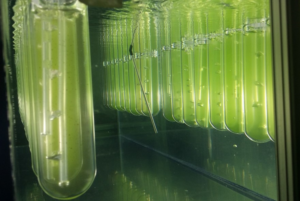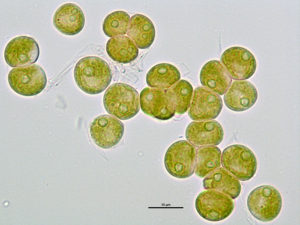Characterizing a productive algal strain is a step toward cost-effectively scaling up cultivation and production.
The Science
The recipe for growing algae as a source of sustainable biofuels seems fairly simple: place these algae in a container with access to sunlight, water and carbon dioxide so they can grow, and then harvest for use as biofuels and other bioproducts.
As any good cook knows, recipes can be refined for best results, often by starting with identifying the right ingredients. Researchers collaborating across multiple institutions have sequenced and analyzed the genome of an alga that thrives in saltwater (halotolerant) and produces the most biomass to date of any such strain, identified through a screening and characterization pipeline.
The Impact
Part of the Department of Energy’s work toward developing a clean energy economy is developing alternative sustainable fuel sources. Developing candidate bioenergy feedstocks that can thrive in saltwater mitigates concerns about diverting resources such as arable land and fresh water.
Summary
On the list of candidate bioenergy feedstocks, algae are tiny but mighty. An analysis in the 2017 Bioeconomy Report estimated that the United States has the capacity to produce enough algal biomass to yield the equivalent of 10-27 billion gasoline gallons if target yields could be achieved. Researchers at many national laboratories are working toward that goal.
In a collaborative effort published in Communications Biology, a team involving researchers at the U.S. Department of Energy (DOE) Joint Genome Institute (JGI), a DOE Office of Science User Facility located at Lawrence Berkeley National Laboratory (Berkeley Lab), the National Renewable Energy Laboratory (NREL), and Los Alamos National Laboratory, combined expertise at the National Labs to screen, characterize, sequence and then analyze the genomes and multi-omics datasets for algae that can be used for large-scale production of biofuels and bioproducts.
At NREL, Luke Dahlin in Michael Guarnieri’s group led the effort to screen 107 algal strains, growing them under conditions that simulated summer in Arizona. Scenedesmus sp. NREL 46B-D3, which thrives both in saltwater and wastewater, was identified as a highly-productive algal strain that primarily produces biomass as lipids and carbohydrates. At LANL, Tisza Bell in Shawn Starkenburg’s group conducted a series of experiments on the Scenedesmus strain to find out how well it performed under varying temperature conditions. The Scenedesmus genome was sequenced and assembled at the JGI. Sara Calhoun in Igor Grigoriev’s team at the JGI led the multi-omics analysis effort for a more complete picture. The team annotated the algal genome and analyzed its metabolome to understand the metabolic processes involved in responding to various stresses, and its transcriptome to learn more about which genes expression patterns. The analysis led to the identification of several transcription factor regulating genes and enzymes that can modify composition of algal lipids. This knowledge could be useful for controlling the lipid content of biofuels sourced from algae.
The collaborative approach highlights how the pipeline could help researchers accelerate efforts to identify and characterize more industrially relevant algal strains, and chart exploratory paths for strain improvements.
Contacts:
BER Contact
Ramana Madupu, Ph.D.
Program Manager
Biological Systems Sciences Division
Office of Biological and Environmental Research
Office of Science
US Department of Energy
[email protected]
PI Contact
Igor Grigoriev
Algal Program head
DOE Joint Genome Institute
[email protected]
Funding:
This research was supported by the Bioenergy Technology Office (BETO) within the Department of Energy’s Office of Energy Efficiency and Renewable Energy (EERE) under Agreements NL0032355 and NL0032266. This work was also completed in part by the National Renewable Energy Laboratory, operated by Alliance for Sustainable Energy, LLC, for the U.S. Department of Energy (DOE) under Contract No. DE-AC36-08GO28308. The work conducted herein by the U.S. Department of Energy Joint Genome Institute, a DOE Office of Science User Facility, is supported by the Office of Science of the U.S. Department of Energy under Contract No. DE-AC02-05CH11231.
Publication:
- Calhoun S., Bell T.A.S., Dahlin L.R. et al. A multi-omic characterization of temperature stress in a halotolerant Scenedesmus strain for algal biotechnology. Commun Biol. 4, 333 (2021). doi:10.1038/s42003-021-01859-y
Related Links:
- JGI’s PhycoCosm data portal for algal genomics
- Scenedesmus strain is available on PhycoCosm
- Video: Sara Calhoun on multi-omics investigation of Scenedesmus at the 2019 JGI Annual Meeting
- JGI Webinar: Watch a recording of the PhycoCosm tutorial
- DOE Bioenergy Technologies Office’s (BETO) Advanced Algal Systems program
- 2020 Federal Activities Report on then Bioeconomy: Algae
Byline: Massie S. Ballon

